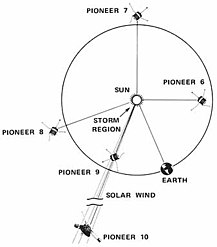Pioneer 9
| Pioneer 9 | |||||||||||||
|---|---|---|---|---|---|---|---|---|---|---|---|---|---|
 Artist's impression of the probe |
|||||||||||||
| NSSDC ID | 1968-100A | ||||||||||||
| Mission goal | Investigation of interplanetary space | ||||||||||||
| Client |
|
||||||||||||
| Launcher | Delta-E | ||||||||||||
| construction | |||||||||||||
| Takeoff mass | 147 kg | ||||||||||||
| Course of the mission | |||||||||||||
| Start date | November 8, 1968, 09:46 UTC | ||||||||||||
| launch pad | CCAFS , LC-17 | ||||||||||||
| End date | March 3, 1987 | ||||||||||||
|
|||||||||||||
Pioneer 9 was a space probe from the US space agency NASA as part of the Pioneer program. It was the fourth of four successful and one failed Pioneer probes to measure solar activity and its impact on interplanetary space. Like Pioneer 6 , Pioneer 7 and Pioneer 8, it should take measurements in a heliocentric orbit and warn of solar storms , among other things .
construction
Pioneer 9 had a cylindrical body with a height of 81 centimeters and a diameter of 94 centimeters. In addition to an internal battery, the probe was covered with a total of 10,368 solar cells on its body to ensure the power supply. The probe was twist stabilized and had several nozzles operated with nitrogen. In addition, two rods aligned with the interplanetary magnetic field provided the necessary stability. There were a total of eight different instruments on board, including a magnetometer , an instrument for measuring the solar wind , a telescope for measuring cosmic background radiation , an instrument for measuring dust and a detector for plasma waves . In addition, the same rocket launched the Tetr-B satellite, which was used for training communication within the framework of the Apollo program .
mission
After launch, Pioneer 9 was placed in a heliocentric orbit between Earth and Venus . A rotation of 60 revolutions per minute around the longitudinal axis of the probe ensured spin stabilization . The measurement results were temporarily stored on a tape drive and then transferred to the ground station. Like its predecessors, Pioneer 9 was only designed for an operating period of 6 months, but it provided data for much longer.
Results
The mission was a complete success. Pioneer 9 was designed for a lifespan of around 6 months, which it more than exceeded. It also provided data on solar storms that were used by more than 1,000 institutions and companies. A final attempt to reach the probe failed on March 3, 1987. As a result, the mission was officially declared over. This made Pioneer 9 the first of the four probes to go out of service.
Web links
- Bernd Leitenberger: The Pioneer Program
Individual evidence
- ^ Pioneer 9th NSSDC, accessed August 1, 2014 .
- ↑ Solar System Exploration: Pioneer 9. (No longer available online.) NASA, archived from the original on April 15, 2016 ; accessed on April 15, 2016 . Info: The archive link was inserted automatically and has not yet been checked. Please check the original and archive link according to the instructions and then remove this notice.

